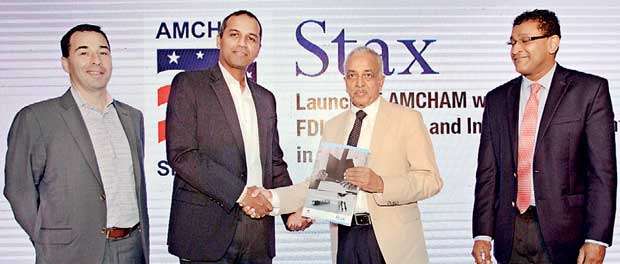13 Jul 2018 - {{hitsCtrl.values.hits}}

From left: AMCHAM President Kumudu Gunasekera presenting the “FDI Landscape and Investor Sentiment in Sri Lanka 2018’ report to Development Strategies and International Trade Minister Malik Samarawickrama in the presence of Stax Inc. and Stax Dev Corp Founder and CEO Rafi Musher (extreme left) and BOI Director General Duminda Ariyasinghe
Pic by Pradeep Pathirana
By Nishel Fernando
Sri Lanka scores low on providing a conducive business environment for US companies operating in the country owing to policy instability while conditions for attracting Foreign Direct Investment (FDI) from U.S. companies remain undesirable, according to a latest report by American Chamber of Commerce (AMCHAM) and Stax Inc.
Addressing the launch of a report titled ‘FDI Landscape and Investor Sentiment in Sri Lanka 2018,’ in Colombo yesterday, Stax Inc. and Stax Dev Corp. Founder/CEO Rafi Musher highlighted that 59 percent of the US companies operating in Sri Lanka have faced operational challenges due to policy instability and 63 percent were troubled by shortage of qualified labour.
US was among the top 10 countries of origin of FDI inflows to Sri Lanka. However, it accounted only for 4 percent (US $23 million) of BOI investments in 2017.
“From a US perspective, conditions for attracting FDI are not optimal. The current quantity of US FDI flowing to the country is not sufficient,” the authors of the report noted.
According to the report, over 57 percent of the US companies, which are members of Amcham, have attracted FDI into the country at some point. However, the majority of the FDI was one off – usually at the inception, with only 18.5 percent of respondents attracting FDI on a recurring basis.
“Unpredictability is one of the biggest hindrance to FDI into Sri Lanka as well as our business – there is no industry dialogue with the relevant line ministers, and fast decisions are made for PR reasons,” a US beverage manufacturer stated in the report.
The authors stressed that lack of transparency and corporate governance in the local business environment also need to be addressed by the government parallel to the reforms carried out at a regulatory level in order to improve the FDI inflows from US.
“My main concern is the political instability. Moreover, we need a good balance between just governance and speed of execution. Sometimes, democratic decision making means this government is very slow to act,” a US apparel manufacturer operating in Sri Lanka was quoted as saying in the report.
Problem of multiple FDI data
Meanwhile, the report indicated that multiple sets of data on FDI could also lead to confusion among potential investors.
“FDI figures also have a signalling effect on potential new investors. In recent times, there has been a discrepancy in FDI figures by the media and various other sources,” it stated.
The authors noted that the FDI data published by the Central Bank are not according to the standard International Monetary Fund (IMF) definitions, and do not paint an internationally comparable picture as the data includes loans taken from external foreign parties, providing an inflated figure.
According to direct investments, excluding foreign borrowings, FDI inflows dropped by 30 percent during 2011-2015 period—largest decline being recorded in 2015.
However, in contrast, the Central Bank figures indicate an increase of inflows during 2011-2014 period.
The authors of the report pointed out that the Central Bank could play a more active role in FDI data collection to paint a clearer image of FDI inflows to the country and said the US investments might have been understated by the BOI as investments facilitated by the investment promotion agency tend to have a heavier focus on capital-intensive, outsourceable sectors such as manufacturing, due to the nature of incentives offered, while investments in areas such as services tend to come in via channels outside of the BOI.
Hence, the authors pointed out that the country specific data for overall FDI from US could be computed through the raw data collected by the Central Bank. However, they pointed out that such data is not published as a practice.
Meanwhile, the report showed that Sri Lankan regulators value the impact made by US investors in Sri Lanka less than that of Asian players such as China.
It also suggested that Sri Lanka will have to maintain sustained policy stability over a number of years before the US investors begin to trust the process.
It also recommended Sri Lanka to consider aligning education and training with new growth sectors and look at short term fixes such as immigration in order to address the skilled labour shortage.
According to the report, 67 percent of US companies operating in Sri Lanka said that the country’s strategic geo-political positioning and quality of labour were the main reasons to invest in Sri Lanka while only 15 percent companies said tax incentives were the main reason.
17 Nov 2024 17 Nov 2024
17 Nov 2024 17 Nov 2024
17 Nov 2024 17 Nov 2024
17 Nov 2024 17 Nov 2024
17 Nov 2024 17 Nov 2024